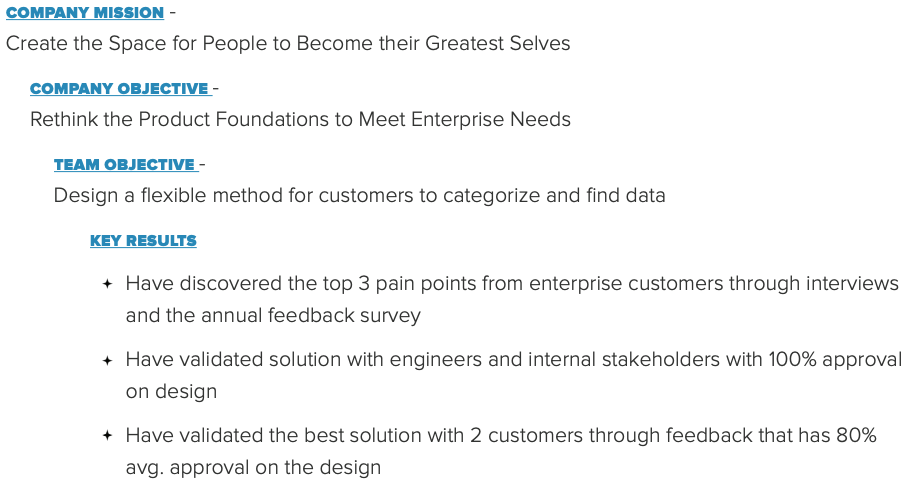Using Passion To Drive Purpose: Three Tips For Writing Effective OKRs
When a company and its leaders aspire towards a common goal, success
isn’t merely achievable, it’s the natural result. Connecting ambition to
purpose is how the impossible becomes attainable, especially in the
workplace. Through the use of company Objectives and Key Results (OKRs), many leaders have successfully created high-performing teams who feel engaged and fulfilled at work.
Leaders must connect people’s work to a deeper purpose through their company mission.
While increasing revenue, adding MQLs, or improving customer NPS are
all important places to focus, most people are driven by impact, not
numbers. In other words, the Key Results are measurable and the company Objectives are what’s meaningful and inspirational.
We’ve all heard about how powerful OKRs are, but the reality is that most people do them wrong. Employees often end up using this system as an over-complicated task list instead of a measurable guide to progress. So, how do you write effective OKRs? The excerpt below is from 15Five’s Comprehensive OKR Guide that shares best practices to help you create powerful company Objectives and effective Key Results.

Examples of Stellar Objectives
Here are some great examples of Objectives in common categories where a company wants to create impact:
• Recruit and hire phenomenal people to take us to the next level (company growth)
• Raise the bar on product UX (quality)
• Sustainable repeatable lead generation (revenue)
• Pay everyone generously for their hard work (performance)
To show what not to do, here are some examples of terrible objectives (but these are actually fantastic Key Results):
• Interview 5 applicants for the role of Design Lead by April 30
• Increase code coverage to 90%
• Hit 732 ICP leads by end of Q2
• Build out accurate job descriptions for 75% of our jobs
The first set of examples are great Objectives because they’re time-bound, qualitative, and meaningful. Words like “raise the bar” or “phenomenal” are designed to empower those aiming for that particular Objective. In contrast, each of the terrible Objectives above are too quantitative and specific, making them intimidating to take on with gusto.
OKRs should be made company-wide, by each department, and for the individual. In fact, Objectives become far easier to achieve if each individual can match their Key Results to overarching company-wide Objectives. As a reminder, don’t forget to align the company’s mission with each OKR to ensure its purpose is driving your main goals.
Here’s an example of a top-down creation of OKRs:

As you can see, the company’s main Objectives should trickle down all the way into the individual Key Results of each employee. Now, you may be thinking, “where do I begin?”
The abbreviated primer below on Best Practices for writing effective OKRs was created by Burst Forward, a consulting and training firm that has helped leadership teams in over a dozen industries with their annual goal-setting and strategy process, including 15Five customers. If you could use more hands-on support in implementing the principles mentioned here when creating your company OKRs, contact Burst Forward.
Tips for writing effective OKRs
1. Less is more
Most teams or individuals start out with way too many OKRs because they believe that’s what it means to be ambitious. But your OKRs should never be used to set metrics that fall under the “business as usual” or “work as usual” buckets—it is not a laundry list of your overall work deliverables. Nor can a team or company realistically achieve multiple extremely challenging goals all at once that pull them in different directions and confuse them on what matters most.
If your CEO asks you to choose,
which OKR would make the most significant difference to how your
company operates? Which would change the rules of the game in your
industry? Which OKR would really inspire and challenge your people to do their best work? Therein lies your answers.
2. Balance Ambition and Success
By this we mean balancing commitment-based Key Results (where you are expected to hit 100% of your metric) with aspirational-based Key Results (where you have only 50-70% chance of actually hitting your metric).
Commitment-based metrics are traditionally how most goal-setting
methodologies have occurred in the past, and it is still how many
organizations set goals. It can be particularly effective for certain
goals (such in sales)
where your quota determines your success. However, OKRs by and large
asks you to go for the stretch. Why? Because those who stretch more
often do more. Perhaps more than they ever imagined possible.
The research for setting stretch goals goes back to Edwin Locke’s ground-breaking work
in the late 1960s that advocated for setting challenging goals. So how
much does one stretch? A goal that still has around a 50 percent chance
of success is a happy medium, since it is both difficult, but still
attainable. Set something too unattainable and you could easily get
discouraged and give up when you are still starting out but repeatedly
failing. Set something too easy and you’ve limited your potential.
We have found that if you are still fairly new to setting and using OKRs in your organization, a good starting place to maintain this balance is to make one Key Result per Objective aspirational in nature. The rest of the Key Results for that Objective can remain commitment-based so you can get the satisfaction of having some successes, in addition to getting used to stretching more than usual.
3. Watch out for unintended consequences in the long-term
We see this often when we look at the goals of organizations starting out with this process. They set goals that are focused purely on quantity-based metrics or heavily skewed towards only tracking revenue. But goal-setting should be a balanced and nuanced process.
For example, if through hard work and substantial luck your company achieves an ambitious revenue goal for the year, but your workforce is burned-out and attrition rates are getting high, will you really have a viable growth business left in the following years? If your new software release has more features than the competition, but is riddled with bugs, at what point will it start to damage the reputation of your company?
To avoid unintended consequences, be sure to counterbalance quantity metrics with quality metrics and short-term ambitions with the long-term viability and desires of your organization. Otherwise you may find yourself winning the round, but losing the game.
Leaders, take these tips with you as you build out your company’s OKRs. You can continually reference them as you create new ones each quarter and as a guide for managers and employees when writing their team and individual OKRs.
Writing effective OKRs should not be confused with list-making, but rather a way to align each and every employee to the company mission and highest priorities. This foundation allows you to create manageable benchmarks so that every employee is successful, and in turn, so is the company.

David Hassell is co-founder and CEO of 15Five, industry leading continuous performance management software that helps leaders and managers drive high performance by bringing out the best in their people. David formerly served as President of the San Francisco chapter of the Entrepreneurs’ Organization and was later named “The Most Connected Man You Don’t Know in Silicon Valley” by Forbes Magazine. David has been featured in The Wall Street Journal, Inc., Entrepreneur, and Wired. Follow him on Twitter @dhassell.
Photo by David Iskander on Unsplash




